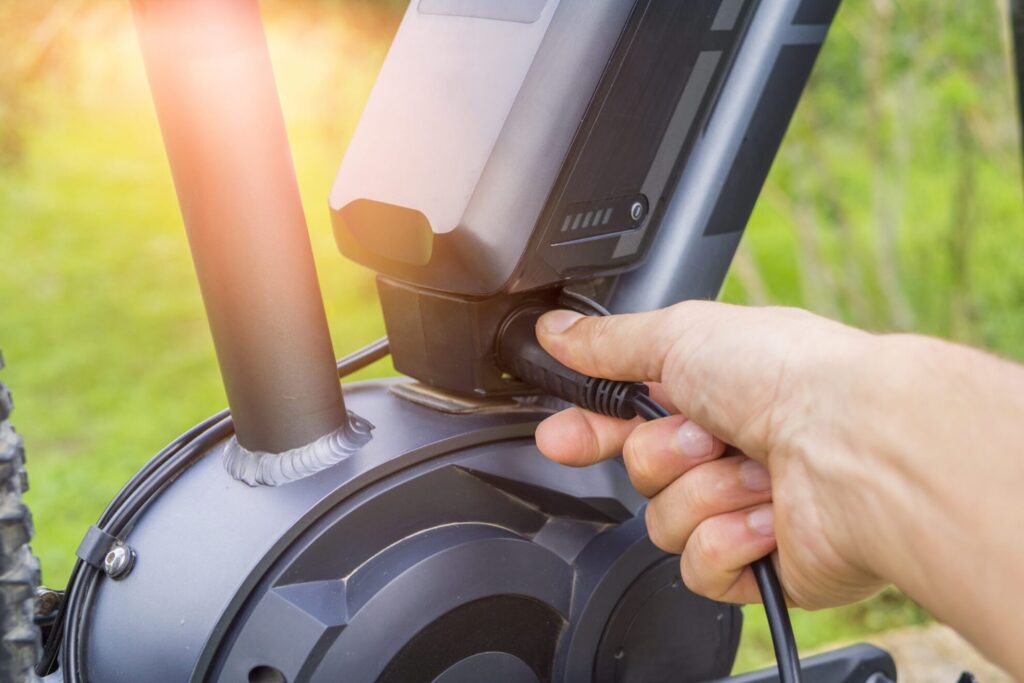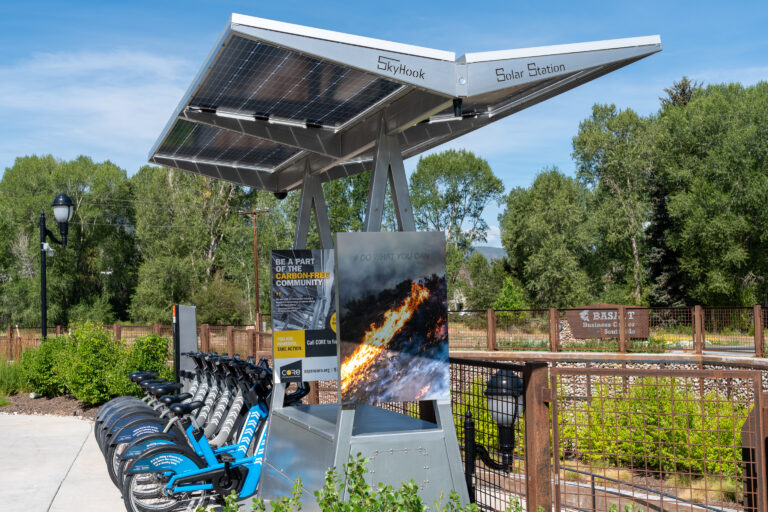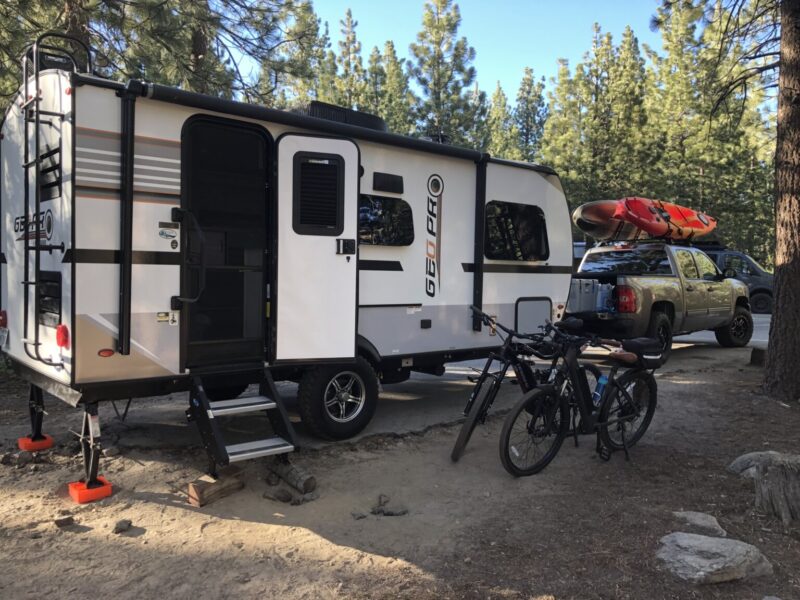Thanks for your support! If you make a purchase using our links in this article, we may make a commission. And, as an Amazon Associate, I earn from qualifying purchases. See the full disclosure here.
Ebikes have become increasingly popular in recent years, and more and more RVers are buying them. Whether you have one or are considering buying one, you’ve probably wondered how to charge an ebike while camping.
Thankfully, there are many ways to do so. We’re going in-depth on e-bikes and how to charge them while camping.
How Often Do You Need To Charge Your Ebike?
Before we get into how to charge an ebike while camping, let’s talk about how often you’ll actually need to charge it. When you first get your ebike, you’ll need to do an initial charge for around 12 hours.
After this, most manufacturers recommend charging your ebike after each significant use. So, if you use it for more than an hour or so, you should plug it back in to charge.
There’s no need to let your battery fully discharge before recharging. In fact, it’s recommended to recharge when at 30% to 60% charge.
That said, some experts do recommend doing an occasional full discharge of the battery before recharging. Generally speaking, you should do so every 30 to 40 charges. Refer to the manufacturer of your e-bike for the best charging procedures.

How To Charge An Ebike While Camping
Now that we know how often to charge, the next step is understanding how to charge an ebike. Doing so while camping can present its own challenges so let’s get into it.
The four most likely ways you will be able to keep your ebike ready to go are shore power, solar, your RVs battery bank, or a generator.
If there are available outlets at your site’s power connection this will be the easiest method. If not, you can utilize your RV or the power of the sun as we’ll look at next.
Can You Charge An Ebike With Your RV?
There are actually a few different ways you can charge an ebike with your RV. Perhaps the simplest is via a shore power connection. Simply plug in your RV to shore power, and then connect your ebike to charge.
Another way is to use your RV’s battery bank if you aren’t connected to shore power. The 12-volt power will have to be safely converted to 120-volt AC which means your RV will have to have a pure sine inverter which most newer RVs do.
If using battery power, it’s important to monitor charge levels to ensure you don’t drain your batteries.
If your RV has a generator, this is also a great option. Just like with charging off of batteries, you’ll need a pure sine inverter to safely charge your ebike. This will likely be built into your RV generator.
The pure sine wave inverter is critical as ebike batteries, like the sensitive electronics in your RV, require clean, steady power.
Can You Charge An Ebike With Solar?
If you don’t have access to shore power, for example, if you’re boondocking, then solar power is another great option. The simplest way is to use a solar power station, AKA a solar generator. Connect your solar panel to charge the power station, then use that to charge the bike.
If you have a separate portable solar setup, simply set up the solar panel, connect it to the charge controller and inverter, and then connect your bike. Keep in mind, however, that depending on your solar panel, charging could take a while.
If you only have a small solar panel, you may be waiting a while for your next ride. However, if you have a larger panel or multiple solar panels, charging will go much more quickly.
Do Campgrounds Have Ebike Charging Stations?
As ebikes become increasingly popular, you may have seen ebike charging stations popping up around you. If you’ve seen one, you might wonder if there are any campgrounds that have these charging stations as well.
Simply put, while some campgrounds will, the vast majority of campgrounds do not currently have ebike charging stations. Worse, at present, there’s no easy way to find ebike charging stations in the US. However, as ebikes continue to increase in popularity, we will likely see this change.

How Much Energy Does It Take To Charge An Ebike?
In addition to how to charge an ebike while camping, you might wonder just how much energy is actually required. To find this out, we’ll need to know the bike’s wattage, which measures the flow of electricity.
The exact number depends on your exact bike. Thankfully, calculating how much energy it takes to charge an ebike is fairly simple.
To do so, you’ll need the voltage and amp ratings of the bike, which should be in the manual. Then, you simply multiply them together to get the wattage.
So for example, if your ebike has a 48-volt battery and a controller rated for 15 amps, your calculation will look like this:
48V x 15A = 720 Watts
So in this case, your ebike would consume about 720 watts to reach a full charge.
What’s The Best Ebike For RVers?
There are plenty of e-bikes on the market, ranging from less than great to top-of-the-line. But our favorite e-bikes come from Lectric eBikes.
Lectric Bikes is one of the fastest-growing ebike companies in the world, and they have a wide range of bikes to suit your needs.
The flagship bike is the XP 3.0, also available with a step-through frame. It has 65 miles of range, a powerful 1000W motor, and great features like longevity boosters and hydraulic brakes.
If you need a lightweight ebike, they also have the XP Lite. This bike weighs only 46 lbs to the XP 3.0’s 64 lbs, while still providing up to 40 miles of range.
For long rides, check out the XPremium 3.0. It features an 800W mid-drive motor and two 48V lithium batteries providing up to 65 miles of range. Plus, thanks to its foldable frame, it’s easy to transport and easy to find a place for it in your RV.
The Lectric Bikes line-up is rounded out by the Xpedition and the unique Electrix XP Trike. The Xpedition is made for adventure, with 450 lbs of carrying capacity, dual batteries giving 150 miles of range, and a 1,310W motor.
The Trike, meanwhile, is the world’s first fully foldable electric tricycle, with 60 miles of range and a 1092W motor with differential axle.
4 FAQs On Charging An Ebike While Camping
Got questions about how to charge an ebike while camping? We’ve got answers. Here are 4 frequently asked questions about charging ebikes while you’re camping.
1. Can You Charge Your Ebike with an RV?
Yes, you absolutely can charge an ebike while camping with your RV. You can do so with a shore power connection, via a solar panel, using your RV’s battery bank, or a generator.
2. Is It Safe to Charge An Ebike With An RV?
As long as you ensure a few things, charging your ebike while camping with your RV is absolutely safe. The main thing is to ensure that your ebike is receiving the right kind of power, namely, alternating current or AC.
A shore power connection provides AC power, but for other power sources, the power is direct current, or DC. To ensure your ebike charges safely, you’ll need to use a pure sine inverter to produce clean AC power.
3. How Much Energy Does It Take To Charge An Ebike?
The exact amount of energy it takes to charge your ebike will depend on the ebike itself. Generally, you’ll consume anywhere from 500 watts to 1500 watts to charge an ebike. To calculate exactly how much energy your ebike needs, multiply your bike’s amp and voltage ratings to get the total watts.
4. Can You Charge Your Ebike With Solar?
Absolutely, it’s totally possible to charge an ebike while camping with solar. The simplest and safest way is to use a solar generator.
Final Thoughts About Charging An Ebike While Camping
E-bikes such as the Lectric Ebike lineup are an awesome way to get around. If you’ve wondered how to charge an ebike while camping, the good news is, it’s easy!
You can use any of the methods mentioned above to recharge your ebike. Having shore power is ideal. However, with the right amount of solar, a solid battery bank, or a generator, you can stay charged up.
E-bikes are the perfect way to get around while camping either in the campground or exploring nearby trails or towns. Staying charged up while camping is easy and you’ll always be ready for an amazing ride!
Related Reading
– 11 Awesome Tips For Bike Hire Or Rental Across The Golden Gate Bridge
– 4 Best RV Ladder Mount Bike Racks PLUS Or Favorite Ladder Rack
– 5 Best Bike Campers In The USA
– 5 Best RV Golf Cart Carriers
About The Author:
Ryan Milejczak – Author and Part-Time RVer
Ryan Milejczak (mill-LAY-check) is a full-time freelancer writer and Florida native with a passion for RVs.
Ryan has been writing about RVing and sustainable living for the past 3 years while traveling.
Currently, he’s saving up to do his own camper van conversion, which he plans to take across the US and Mexico.
When he’s not writing, Ryan loves cooking, hiking, practicing his Spanish, and taking care of his plants (currently at 23 plants and counting!)



I receive your newsletters and blogs. I thought that I saved your article on E-bikes, but apparently I didn’t. It was very informative on the types, pros/cons, etc. Please tell me which issue that article was in so I can go find it.
Thank you,
Karol
Sorry to sound negative, but I am having a rough day.
I am tired to read articles that misuse the term “watts” to signify an amount of energy consumed or charged. What is properly measured in watts is the rate of energy flow, also referred to as power. The energy transferred is the wattage multiplied by time, and it is measured in watt-hours, not in watts. I understand that those not familiar with electricity find it-easier to refer to e.g. a battery as being a “1000 watt battery” when it is really a 1000 watt-hour battery. Once such a bad habit takes hold, it is tempting for our esteemed bloggers to use the same terminology, just to connect with the readers. However, doing so leads to misconceptions, and sabotages the prospects of readers ever educating themselves enough to be able to plan their RV electrical system.